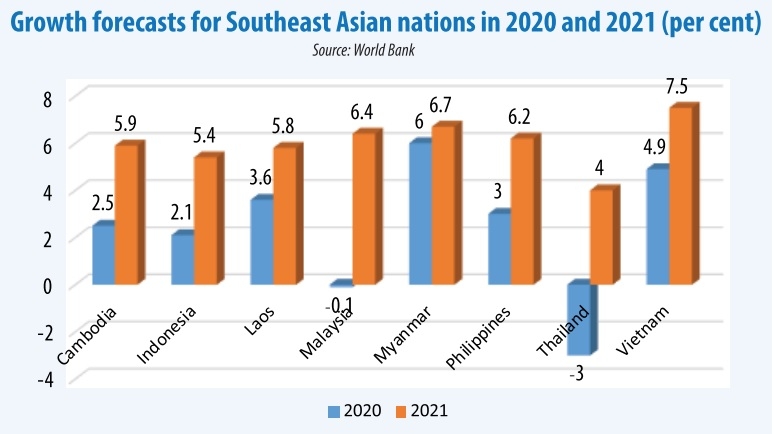Options outlined for lower growth
 |
Last week at the National Assembly Standing Committee’s meeting, Minister of Planning and Investment Nguyen Chi Dung reported that as assigned by the government, his ministry has formulated two economic growth scenarios for 2020. In the first scenario, with Vietnam controlling COVID-19 in the second half of April and its key investment and trade partners doing this in the third quarter of 2020, GDP is expected to increase 4.4-5.2 per cent this year, with the agro-forestry-fishery sector growing 2.5-2.8 per cent, the industrial and construction sector 6.7-7.9 per cent, and the service sector 2.8-3.6 per cent, on-year.
In the second scenario, with Vietnam reining in COVID-19 in the second half of April and its key investment and trade partners doing this in the fourth quarter of 2020, GDP is expected to increase 3.6-4.4 per cent this year, with the agro-forestry-fishery sector growing 2.1-2.5 per cent, the industrial and construction sector 5.8-6.7 per cent, and the service sector 1.8-2.8 per cent, on-year.
The National Assembly Standing Committee suggested that the government needs to consider formulating another growth scenario, with an assumption that the pandemic will surge in the country in this autumn and winter, while COVID-19 may not still be eradicated in 2020. If this bad situation happens, Vietnam’s economic growth may be only 3 per cent this year, affecting the state budget balance and other issues in the economy.
These scenarios, mirroring the government’s caution in monitoring the economy, are to be discussed at the ninth session of the 14th National Assembly, which will last from May 20 to June 19. Last November, the legislature set a growth target of 6.8 per cent for 2020 – whether this rate will be adjusted or not will likely be seen at the session.
Currently, the economy is showing signals of recovery with confidence of enterprises bouncing back, laying firm groundwork for the government to maintain the economy at a growth rate on top of the region.
Prime Minister Nguyen Xuan Phuc has stated that the economy is gradually witnessing normal activities, with enterprises’ confidence beginning to escalate. “The economy is now like a pressed spring which is ready to bounce up,” he said.
Fresh figures from the Ministry of Planning and Investment (MPI) showed that in April, the entire country saw over 3,800 enterprises resume operation, up 11.3 per cent on-month and 40.4 per cent on-year. In the first four months, 17,800 enterprises did so, up 2.1 per cent on-year, raising the total number of newly-established enterprises and those with resumed operations to 55,400.
Moreover, 980 businesses completed their dissolution procedures, down 25.5 per cent on month, and 17.6 per cent on-year. Also, despite numerous difficulties, 11.700 operational enterprises also increased their investment capital by VND681 trillion ($29.6 billion). “This is likely a positive signal that many enterprises are restarting their operations in order to welcome new business and investment opportunities after COVID-19 is controlled,” said MPI Minister Nguyen Chi Dung. “The economy’s mid-term outlook remains quite favourable thanks to high domestic consumption and export demands.”
According to the government, amid difficulties, many enterprises have been maintaining sustainable development with high growth.
“The World Bank has predicted that Vietnam will grow 4.9 per cent this year. In the first quarter, the economy grew 3.82 per cent on-year. Though it was a 10-year first-quarter low, it remains a relatively high growth rate in the global common context,” PM Phuc stated. “The World Bank’s assessment showed that Vietnam is still maintaining its good fundamentals, with the highest growth rate in Southeast Asia and the wider Asian region. Among the ASEAN, Vietnam has the best growth outlook.”
A few weeks ago, the Vietnamese economy was forecasted to rebound strongly next year thanks to a surge in domestic production after the COVID-19 pandemic. The World Bank stated that over the medium term, growth is projected to rebound back to 7.5 per cent in 2021 and converge at about 6.5 per cent in 2022, “reflecting an improved external demand and a firming of the services sector, as well as a gradual recovery in agricultural production. The economy will also rebound from the global coronavirus pandemic.”
Meanwhile, the Asia Development Bank (ADB) has predicted that Vietnam’s economic growth will slow sharply in 2020, to 4.8 per cent, but if the outbreak is contained within the first half of 2020, the rate will rebound to 6.8 per cent next year and remain strong over the medium and long term.
“The Vietnamese government is implementing huge packages to support local production and exports. If these measures are well deployed, they will help the economy bounce back quickly in the second half of 2020 and until 2021,” an ADB expert told VIR. “Despite the potentially large impact of COVID-19, Vietnam’s economic fundamentals remain resilient. Drivers of economic growth – a growing middle-income class and a dynamic private sector, notably household businesses, and domestic ones – remain robust.”
What the stars mean:
★ Poor ★ ★ Promising ★★★ Good ★★★★ Very good ★★★★★ Exceptional
Related Contents
Latest News
More News
- PM orders investment model for North–South high-speed rail (December 22, 2025 | 17:43)
- First members of Danang International Finance Centre revealed (December 22, 2025 | 17:39)
- Securing capital and efficiency for Vietnam’s 2026-2030 growth ambitions (December 17, 2025 | 10:00)
- Driving double-digit growth through green and circular transformation in Vietnam (December 17, 2025 | 09:00)
- Vietnam bucking trend in the global M&A landscape (December 16, 2025 | 14:20)
- Vietnam’s green transition demands collective financial action (December 15, 2025 | 12:00)
- VIR workshop highlights capital and policy for sustainable development (December 15, 2025 | 11:00)
- National Assembly approves pilot mechanisms to accelerate major projects in Hanoi (December 12, 2025 | 11:29)
- Vietnam eases policy approval requirements, simplifies foreign and outbound investments (December 11, 2025 | 17:53)
- Unpacking new momentum in Vietnam’s M&A market (December 10, 2025 | 09:59)

 Tag:
Tag:




















 Mobile Version
Mobile Version